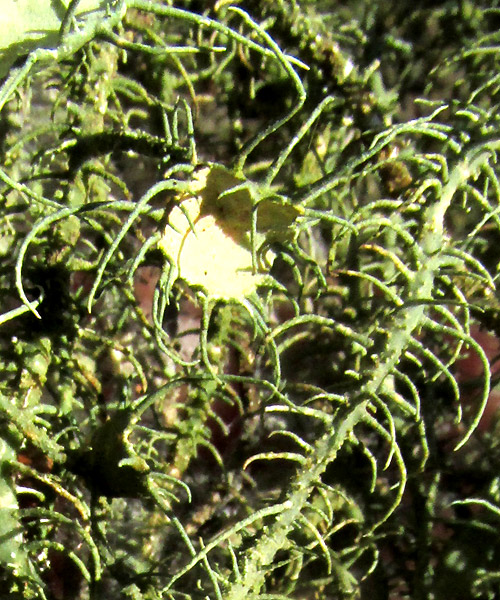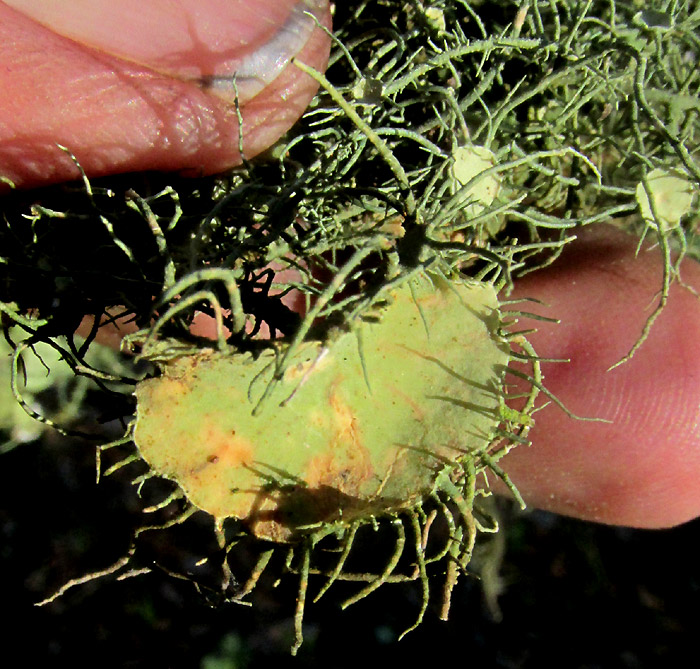Entry from field notes dated September 2, 2023, taken in Los Mármoles National Park in the Eastern Sierra Madre mountains, Hidalgo state, MÉXICO; oak-pine forests along ridge beside road leading to Puerto de Piedra, which branches off the road between Trancas {on maps designated "Morelos (Trancas)"} and Nicolás Flores; limestone bedrock; elevation ~2,550m (~8,400ft); ~N20.81°, ~W99.23°
USNEA INTERMEDIA, maybe
 The long strand of lichen at the right had fallen from high branches of a pine, Pinus hartwegii. It's easy to see that it's one of several species of beard lichens occurring in central Mexico's mountains, genus Usnea, but figuring out which species is a challenge.
The long strand of lichen at the right had fallen from high branches of a pine, Pinus hartwegii. It's easy to see that it's one of several species of beard lichens occurring in central Mexico's mountains, genus Usnea, but figuring out which species is a challenge.

Above, for identification purposes, it's important to notice that the slender, hooking side branches, or fibrils, arise from their stems at right angles, and are attached to the stem in a somewhat random manner, not opposite one another forming a fishbone pattern. The flat-faced, starburst item is the spore-producing apothecium, whose presence in considerable numbers is a good field mark, since by far the greater number of Usnea species only rarely or never develop them. Note that stems and certain fibrils are warty.

Above, the large, oddly shaped apothecium was the most striking and confusing feature of our lichen. At the apothecium's broadest, it is 23mm across, over an inch, and that's huge for Usnea species. On the Internet, I find one instance of a Usnea with similarly large apothecia and same-looking stems and branches identified by an amateur as USNEA INTERMEDIA. That lichen occurred in oak-pine forest in Michoacán state, a couple of states away from us.
The experts at LichenPortal.Org describe the apothecia of Usnea intermedia as 2-13mm in diameter, while other technical sites report 3-15mm. As far as I can determine, no Usnea species is known to develop apothecia 23mm wide. In the above photo, the two smaller apothecia are typical.
Current knowledge about Mexican lichens is limited, so it's quite possible that such large apothecia for Usnea intermedia haven't been recognized in the literature. LichenPortal.Org notes that chemical tests on this species -- normally considered determinative -- are confusing. They write that a specimen containing thamnolic acid has been found in New Mexico, which shouldn't be the case. They sum up by saying that "Detailed studies are needed to understand the signification of these different chemistries."
Therefore, I'm filing these pictures on the Internet under the name Usnea intermedia to enable those studying the species to see what a remarkable thing we've found here -- even though I'm not at all certain it really is that species. For something to be found on the Internet, it must be named, if only so the name can be challenged.
In case our lichen is indeed Usnea intermedia, the species is described as occurring on bark, rarely on wood or rock, mainly in oaks, pines and other conifers in Europe and at high elevations in western North America, and south in the Mexican highlands to about here.